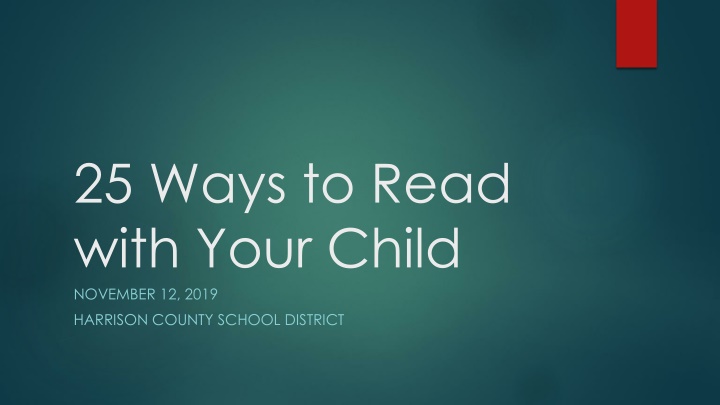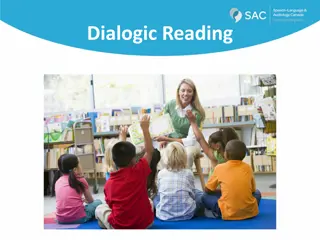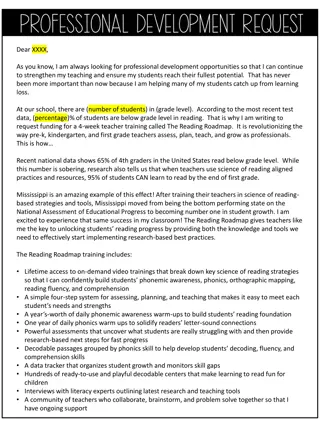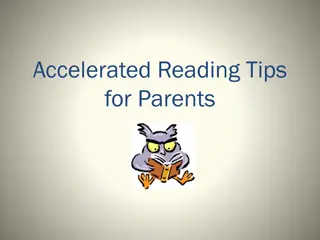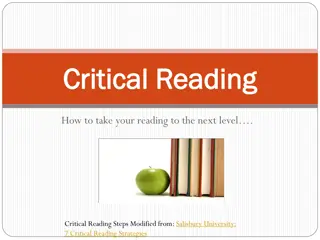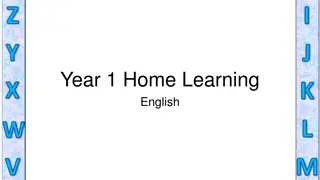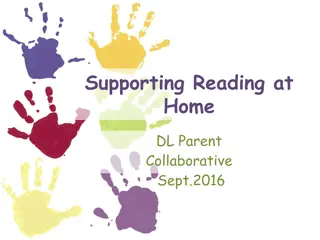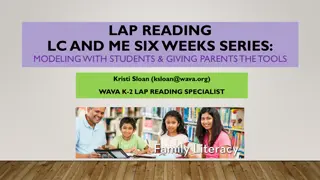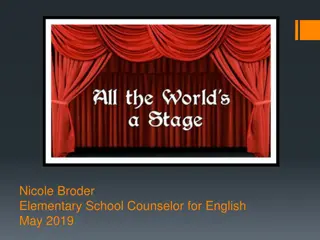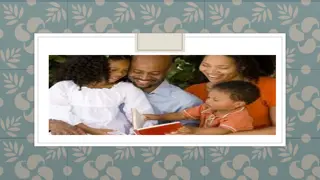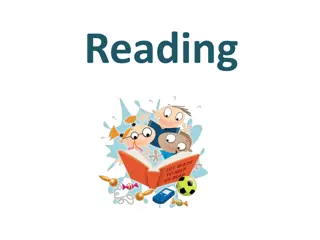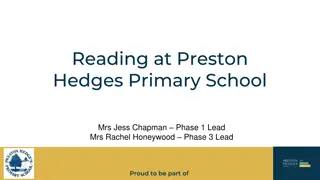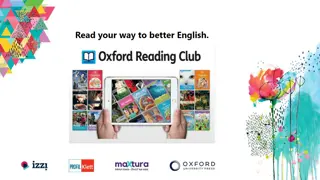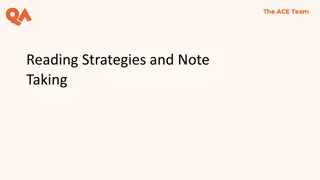Enhancing Reading Skills with Your Child: Tips and Benefits
Explore 25 ways to read with your child to boost their intellect, academic success, vocabulary, writing skills, and spelling. Discover the impact of reading for 20 minutes a day and various techniques like modeling reading, choral reading, echo reading, and more to make reading enjoyable and educational for your child. Remember, any reading time with your child is beneficial!
Download Presentation

Please find below an Image/Link to download the presentation.
The content on the website is provided AS IS for your information and personal use only. It may not be sold, licensed, or shared on other websites without obtaining consent from the author.If you encounter any issues during the download, it is possible that the publisher has removed the file from their server.
You are allowed to download the files provided on this website for personal or commercial use, subject to the condition that they are used lawfully. All files are the property of their respective owners.
The content on the website is provided AS IS for your information and personal use only. It may not be sold, licensed, or shared on other websites without obtaining consent from the author.
E N D
Presentation Transcript
25 Ways to Read with Your Child NOVEMBER 12, 2019 HARRISON COUNTY SCHOOL DISTRICT
True or False? Reading increases intellect. Children who enjoy reading are more academically successful. Reading increases vocabulary. Children who read more produce better pieces of writing. Reading improves spelling.
Have you seen these before?
20 Minutes a day makes a huge difference! A student who reads 20 minutes a day will be exposed to 1.8 million words a year. A student who reads 20 minutes a day will be more likely to score in the 90thpercentile on standardized assessments. A kindergarten student that reads 20 minutes a night will gain the equivalent of 60 school days by the time they finish 6thgrade. If you read one book with your child everyday from their birth to 6th grade you will have read 4,015 books and will have been exposed to roughly 140,000 words.
So, once you carve out 20 minutes how do you read with your child?
Model Read Parent models how the passage should be read Read Together Choral Read Parent read a sentence and have the child parrot or echo the sentence back to you Echo Read Parent read and stop before important words or ideas in the story, when the parent stops, the student picks up where they left off Cloze Procedure Parent read one page; child read the next page Partner Read (Could be one sentence for parent, one sentence for the child) When you read with your children try these techniques: Progress with students gradually and slowly move the extra support by having them read to you!
Remember: It s All Good! Any reading you do with children can only help!
Lets Practice! Model Reading Parent models how the passage should sound Choral Reading Everyone read Echoic Reading Parent read a sentence, child repeats Cloze Procedure Fill in the blank Partner Reading One page for parent, one page for child
So, how do you get your child to read for 20 minutes each day?
#1) Vary WHAT you read. Comic strips Magazines Graphic Novels Recipes/Cookbooks Informational text Wordless books
#2) Vary WHERE you read. Outside under a shady tree, in a park, on the beach Toss a sheet over a clothesline or table and create a hideaway Go on a reading picnic Read at night with flashlights
#3) Start a reading tradition. Start a tradition of reading something particular together (e.g. like the Sunday comics, a children s magazine, etc.). A story on a special occasion (e.g. Your First Birthday, Luke 2, etc.)
#4) Bake a cake. Have children follow a recipe to make a treat. Especially fun when those treats were mentioned in books. Following a specific set of directions helps students understand sequence.
#5) Try tongue twisters. Read aloud books with words you find difficult to pronounce. Dr. Seuss is a master at this one!
#6) The first rule of Book Club is to talk about book club! With older kids, try a book club. Book clubs should be fun, not highbrow. Our mother-daughter book club giggled uncontrollably when we extended the book discussions with questions like, When have you lied and not gotten caught? Hilarious confessions erupted.
#7) Extend the life of characters after the book ends. Keep book characters alive after the book ends by asking questions like, What do you think the characters did next? As your family faces different situations, ask how Olivia, the Pigeon, Batman, or the Little Snowplow would handle the situation.
#8) Read in anticipation of an event. Plan field trips as extensions of your shared readings. Visit construction sites, museums, festivals, music events, or perhaps something somber and soulful. For example, before visiting the beach, read several books about the beach!
#9) Everybody has onewhats your opinion? Kids love to voice opinions. (Don t we all?) After a book, do a simple thumbs-up, down, or in between. Also ask, Would you change the story at all? What should happen next?
#10) Grade level most of the time but below grade level may be your child s comfort level. LET KIDS READ BELOW THEIR AGE OCCASIONALLY. THIS MAKES THEM MORE CONFIDENT READERS!
Expand the list of adults who regularly read with your kids. This exposes them to a wide variety of reading interests, quirks, and styles. #11) Try a guest reader. Ask Grandmothers, Grandpas, Aunts, Uncles, Cousins, Friends!
#12) Informational text opens a world of possibilities. Don t forget there are all kinds of nonfiction!
#13) Dont forget the public libraries! Attend free story times at public libraries and bookstores. If you re lucky, they may host author visits, too. Most libraries sponsor summer reading programs.
#14) Comic strips! This deserves its own spot on the list: read Calvin and Hobbes! Everyone relates to this comic strip! Even the most reluctant readers open up to Calvin. Bill Watterson, who created Calvin and Hobbes, is often called the last great newspaper comic! It began in 1985 and continued until 1995. Children learn that reading can be hilarious!
#15) Audiobooks! Audiobooks!!! Although there are sites/apps like Audible and iTunes that have online audiobooks, you can download the Hoopla app and listen to books free through our public library system. See https://harrison.lib.ms.us/ under the tab E-Services for more details.
#16) Stop, ask a question and listen. Next time you are reading a suspenseful story, intentionally stop reading aloud at an exciting part. Ask questions like, What is going to happen next? Why do you think that? Then ask the child to finish the story on their own!
#17) Chefs Choice let them choose! Let your kids read widely and wildly, their choice of books. Comic books. Nonfiction. Magazines. Cookbooks. The same book over and over. Whatever they choose!
#18) Read to others. Help readers celebrate their skills by reading to a younger child. Or to pets or stuffed animals. Or to a grandparent!
#19) Knock, knock! Whos there? Joke books! Joke books. Yes, they can be annoying and tiresome to adults, but kids love them. Jokes offer quick payoffs, especially for struggling readers. Children learn, not only how to tell a joke, but to laugh at words in print.
#20) Reading Chocolate. Start a tradition of reading chocolate. Grown-ups nibble chocolate while we read, so why not kids? Once a month, as a treat, but the child must read to me while I put groceries away!
#21) Windows & Mirrors One of my favorite quotes is by Rudine Sims Bishop sums this up: Books are sometimes windows, offering views of worlds that may be real or imagined, familiar or strange. These windows are also sliding glass doors, and readers have only to walk through in imagination to become part of whatever world has been created or recreated by the author. When lighting conditions are just right, however, a window can also be a mirror. Literature transforms human experience and reflects it back to us, and in that reflection, we can see our own lives and experiences as part of a larger human experience. Reading, then, becomes a means of self-affirmation, and readers often seek their mirrors in books.
#22) Reading is a reward. Use gifts of books as treats and rewards for your children, not as tasks and assignments.
#23) Share the reward. Help your kids share the joy of reading by donating books. Donate them to the little libraries, homeless shelters and Head Start centers.
#24) Let them see you read for pleasure. Read and chat about books in front of your kids. I love my childhood memories of a friend always greeting Dad with Whatcha reading now? or of Mom laughing out loud while reading.
#25) Make an appointment with your child to read. Set a specific time each day to read with your child. My daughter (who is 16) loves that we read each night before bed. Sometimes it is a Pinterest article, sometimes a Rick Riordan book but we always read before bed even if I am away for the night, we FaceTime or read over the phone.
References Reagan, J. (2019). How to Make Reading Fun: 25 Ideas Kids Will Love | Brightly. [online] Brightly. Available at: https://www.readbrightly.com/how-to-make-reading-fun-25-ideas- kids-will-love/ [Accessed 7 Nov. 2019]. The Parent Institute. (2018). 25 Ways Parents Can Read With Children. [online] Available at: https://www.parent- institute.com/product/302a [Accessed 7 Nov. 2019]
